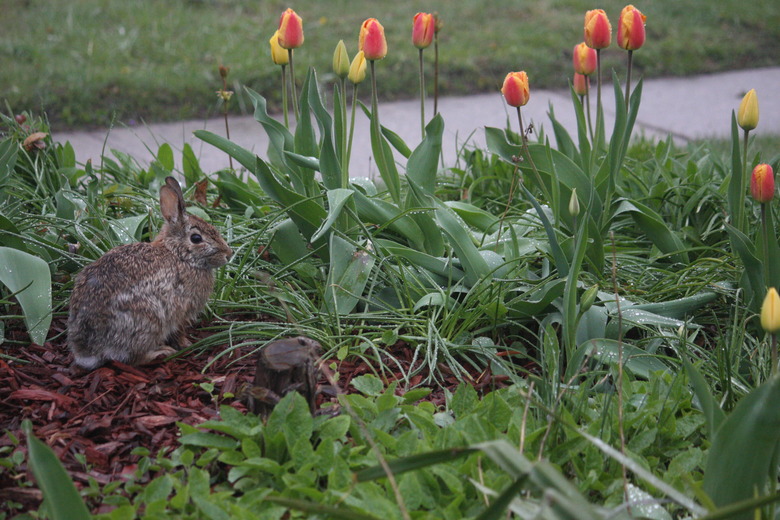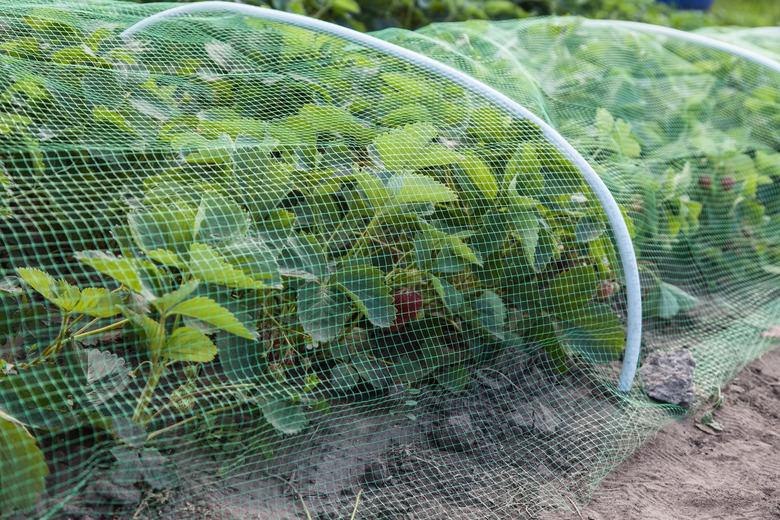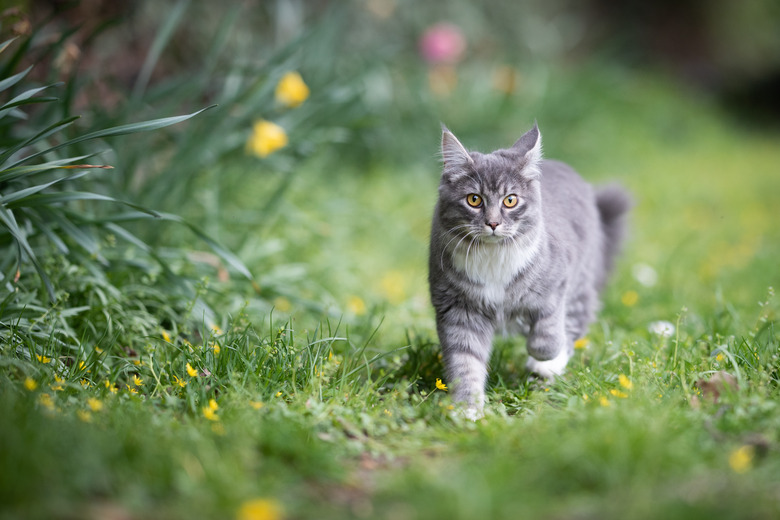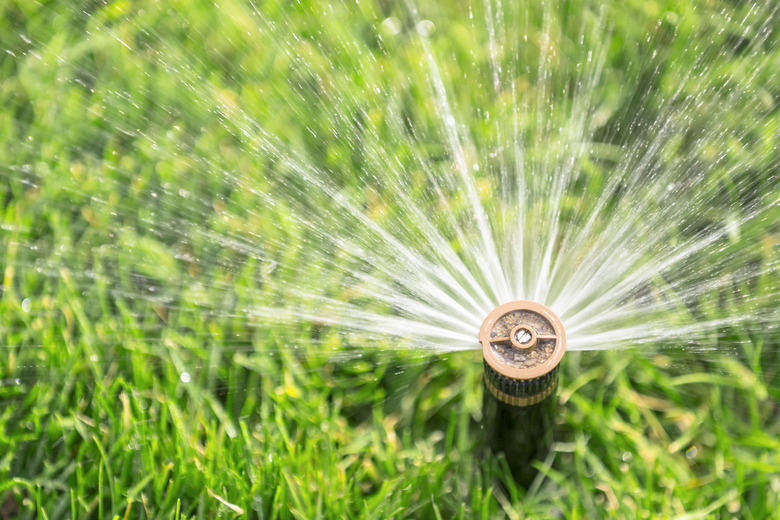7 Ways To Keep Critters Out Of Your Garden
Nothing is quite as disappointing as heading out to the vegetable garden to collect your prize only to find that a critter has beaten you to it. Even ornamental plants aren't safe, as many animals will eat a wide variety of plant leaves and leave your flower beds looking ratty. The truly tenacious animals, such as groundhogs, may even have the audacity to uproot your plants completely.
Fortunately, you can resolve garden pest problems in a DIY fashion — without having to call in the pros for an expensive extermination. The first step is figuring out the kind of pest with which you're dealing. Deer, for example, leave behind cleanly stripped stalks and stems. Rabbits tend to shear off plant stems at ground level, while groundhogs bulldoze entire plants and dig holes in the garden. Chipmunks and squirrels prefer seeds and will likely destroy your garden before it even germinates. To get results, you'll need to use the right deterrents for the particular critter with which you're feuding.
1. Basic Housekeeping
1. Basic Housekeeping
The simplest way to keep critters out of your garden is to make sure you haven't accidentally rolled out a red carpet for them. Just like people, animals want to live in nice houses close to a food source and water. You'll never get rid of your unwanted visitors if your garden offers all three of those things.
Make sure you rake up dead leaves, keep your grass short and remove any brush piles from your yard. Seal off areas under porches and decks as well and eliminate any buckets, wheelbarrows or containers that hold water. If you compost, do so in a bin to help keep nesting rodents and scavenging raccoons out of the pile.
It's also important that you keep your lawn free of grubs. Skunks and moles love to eat grubs. If you have grubs in your lawn, these creatures will often come for the grubs and will view your plants as a tasty salad bar.
2. Proper Fencing
2. Proper Fencing
Fencing can serve as a great way to keep certain critters out of the garden. The type of fencing you choose will depend on your ultimate goals. It can be a basic wooden fence, a decorative fence or a fence made specifically for repelling critters. Even some simple chicken wire will do. The main thing to remember is to keep any holes in the fence small so garden visitors can't weasel through them.
If you're dealing with deer, go tall. Ideally, a fence that stops deer should be 8 feet high. If your local zoning ordinances don't allow that, make sure your fence is at least 6 feet tall. The deer will simply jump over anything shorter. This spectacle is both impressive to watch and frustrating to behold.
Deer fencing doesn't have to be fancy. You can use snow fencing, chicken wire or even large screens to keep them out. Because it's so tall, however, deer fencing is often highly visible. This prompts many gardeners to install attractive wooden or vinyl fencing to keep deer out without creating an eyesore.
If your problems are happening on a smaller scale, you may opt to build a short, simple fence made of chicken wire or metal hardware cloth to protect your garden from rabbits or groundhogs. Voles can get through chicken wire, and squirrels and chipmunks can easily climb over chicken wire and hardware cloth fences — regardless of the height. And if you don't bury the bottom of your chicken wire at least 6 inches into the ground (10 inches is better), many critters will simply dig under it.
3. Wire Cloches and Row Covers
3. Wire Cloches and Row Covers
If you have small garden plants to protect, a wire cloche is a terrific way to do it. These small wire devices sit over the top of plants to protect them and do so without blocking water, sunlight or airflow to the plant. A wire cloche keeps skunks, rabbits, deer, squirrels and most other critters away from the plants while simultaneously excluding birds.
Cloches generally work well and will protect your plants from just about any garden pest except those that could dig underneath it. It's also important to note that cloches are very light. A larger animal, like a deer, could figure out that it can nudge the cloches aside and still get a snack.
If you have tall plants, a lot of plants or persistent deer, consider floating row covers instead. Simply install a series of hoops over your plant and then stretch the cover over them, staking it down every few feet. This allows you to cover larger plants more easily, essentially working like a giant cloche. Row covers and plant tents eliminate many insect pests as well as animals, but they also keep out essential pollinators for insect-pollinated crops. Just make sure that you uncover your plants during the day when they're flowering and replace the cover each night during this pollination window. When the flowers give way to tiny fruits, you can keep your plants covered all the time. Row covers are designed to trap heat to protect plants from cold; make sure it's OK to leave covers on so you don't overheat your plants.
4. Elevated Flower Beds
4. Elevated Flower Beds
Raised planting beds are an excellent way to make gardening easier on your back while keeping critters at bay. Obviously, a raised flower bed won't deter deer or birds, but animals like groundhogs, voles and rabbits can't reach raised beds. Beds as little as 2 feet off the ground are all you need to deter animals that can't climb or fly.
You can also opt to grow some of your particularly tasty plants in containers. Containers are often tall enough to discourage most visitors even if you set them directly on the ground. For extra protection, however, use hanging planters or window boxes for some extra height.
5. Get a Pet
5. Get a Pet
Sometimes, another animal is the best way to repel unwanted visitors. Although spoiled house cats do sometimes get lazy, there are lots of cats that make excellent mousers. Cats in the garden can catch moles, voles, mice and other smaller animals. They'll also leave their scent behind, which may scare off some critters that don't want to become a meal.
The same is true for dogs. Although not true of every pup, many dogs have a strong prey drive and will be happy to chase down pests, like rabbits and groundhogs, that might be too big for a cat. Like cats, dogs have a scent that can deter future animal visits.
6. Make Your Garden Taste and Feel Bad
6. Make Your Garden Taste and Feel Bad
If you don't want animals to eat your plants, make them taste bad. One way to do so is to choose plants for which animals have a natural distaste. Rabbits, for example, are said to hate marigolds (Tagetes spp.), while deer have an aversion to foxglove (Digitalis purpurea) and lavender (Lavandula angustifolia).
If you've already planted tasty treats, you can change their flavor with sprays. A spray made of 1/4 cup of milk and a few drops of dish soap may keep deer away from some of your plants, but bear in mind that hungry deer will eat almost anything, regardless of whether it's coated in milk and soap. In fact, university research has shown that deer may actually be attacted to some soaps, notably those made with coconut oil. And if you use a soap spray, you'll have to reapply it after each rain event. For a more general repellent, many gardeners swear by sprays made of hot sauce and water as well as castor oil. Garlic and mint oils may also work. Of course, you can also use store-bought animal repellents.
Unfortunately, these spray-on repellents and pellets have their limits. They can work, but you must remain diligent. Their effectiveness will fade over time, and they will need to be reapplied frequently.
On the plus side, taste and smell aren't your only weapons. Texture can also make plants unappetizing. Thorny plants present obvious problems for hungry animals. Many critters dislike plants with fuzzy leaves, and rabbits tend to avoid plants with woody stems in favor of those that are more tender.
7. Add Noise, Water, and Movement Devices
7. Add Noise, Water, and Movement Devices
Many gardeners attempt to deter unwanted visitors by scaring them off. Some use motion-activated sprinklers that shoot a jet of water in the direction of unwary animals. If you install one of these systems, know how to turn it off and where exactly it shoots its water stream, or the unwary animal could be you (or your neighbor). Water jets usually work well at startling the animal without harming it.
Some gardeners use noisemakers to scare off creatures that wander too close to the garden. Many of these devices emit sounds in pitches that humans can't hear to annoy animals but not your neighbors. Unfortunately, it can be hard to know if a device you can't hear is working properly or not, and it may annoy your pets along with the local wildlife.
Some devices simply use motion or lights. Rabbits, voles, groundhogs and other smaller critters often serve as prey animals for large birds. As such, they're wary of movement. Many gardeners take advantage of this and hang old compact discs in the garden or install pinwheels.
Although movement will often startle away animal visitors, gardeners sometimes combine movement and noise. Wind chimes or homemade devices made of hanging metal pie tins or aluminum cans move and make noise, offering a two-pronged approach to chasing off pests. Other gardeners prefer far simpler methods and keep animals at bay by simply placing owl figurines or fake snakes in the garden.
These devices sometimes work but may be effective only in the short term. Some animals are pretty smart, and eventually, they figure out that they can avoid a water jet if they come into your garden using a certain route. They may also realize that your wind chimes never move far or that the strange noises coming from your garden are always exactly the same. These techniques are inexpensive and worth a try but don't be too surprised if one day you look out the window and see birds roosting on the arms of your scarecrow.
References
- Farmers' Almanac: Keep These Pests Out of Your Garden Naturally
- Country Living: 10 Ways to Protect Your Garden from Critters
- Eartheasy: How to Keep Animal Pests Out of Your Garden
- Gardener's Supply Company: Keeping Animal Pests Out of Your Garden
- The Old Farmer's Almanac: Deer-Resistant Plants
- SignalsAZ: Beautiful Flowers That Animals Don't Like
- Universty of Georgia Extension: Repellents and Wildlife Damage Control



